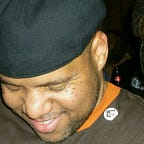Black History Month — 2019: The Civil Rights Side Eye
“Public accommodations are a right that cannot be given or taken away by a vote.” — Gloria Richardson
An Iconic Image
I’ve spent years looking at this picture. Here’s a black woman, during the 60s, standing in the street, giving the ultimate side eye to a National Guardsman, with her hand on his rifle, pushing it away, as if to say, “Man, if you don’t get this gun out my face…” I found out that the woman in the picture, that I’ve been in awe of your years, was Gloria Richardson.
Not All Heroes Wear Capes
Gloria Richardson was born in Baltimore. At age 6 she and her family moved to Cambridge during the Depression. She attended Howard University at the age of 16. Richardson earned a B.A. in sociology from Howard in 1942. Cambridge and its schools remained segregated long after the Supreme Court ruled “separate but equal” was unconstitutional in 1954. At the time, Richardson was a 45-year-old, mother of two. She not only lead a movement to change this, but she also was respected by a number of key figures of that time, like Robert Kennedy and Malcolm X. They wanted all schools, recreational areas, and hospitals in Maryland to be desegregated.
The Cambridge Movement
While at Howard, she participated in her first acts of civil disobedience. The Cambridge Movement, led by Richardson began in late 1961 and lasted into the winter of 1964. This was also the longest period of martial law within the US since 1877. The National Guardsmen were called in to intimidate those participating in the protests. A photo of Richardson at one of the protests pushing a bayonet away from her is more than just defiance — it was her right and everyone’s right to live. “He was going to stab me, so I had to push it,” Robinson said during an interview with NPR. She was one of the activists honored from the stage during the famous March on Washington in 1963. However, when it was Richardson’s turn to speak she was only able to say “hello.” Her microphone was taken away and she was told there’s a separate tent for women speakers at the march.
Semi-Retirement but Always Helping
Richardson left Cambridge and married a photographer she met during the demonstrations named Frank Dandridge. They moved to New York City. She continued to work various organizations helping out in any way she can. Richardson explained, in an interview, why she was passionate about helping the students and The Cambridge Movement.
“There was something direct, something real about the way kids waged nonviolent war. This was the first time I saw a vehicle I could work with”.
Here are some interviews Gloria Richardson has done with Democracy Now and The Library of Congress. What an amazing person.
References: Baltimore Magazine, Biography.com, and Wikipedia
Black History Month is a time when we all get to dig a little deeper. Learning is fun, and February is exceptionally awesome. There’s always little tidbits or iconic figures that I never heard of. As many of you know I like to focus on a certain topic for Black History Month. It helps me learn, and hopefully you as well. Last year’s topic was civil disobedience. For 2019: The Role of Black Women Played to Shape Our History. -Mark
